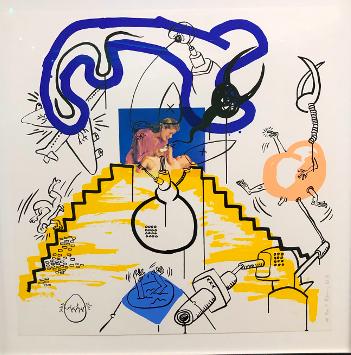
I recently was dragged to enjoyed a trip to the NSU Art Museum in Fort Lauderdale, which featured an exhibit of pop artist Keith Haring. My wife is an artist as well as a licensed art psychotherapist (1), and she was pointing out all kinds of not-so-hidden imagery in Haring's work – things that my "art pea brain" couldn't comprehend. It was fascinating. More on this later.
What does the work of a well-known artist, who started his career spraying graffiti in subways in (where else?) New York, have to do with Magic Johnson and the stinky Lakers? Plenty. It's all about timing.
Magic Johnson unloads on the Lakers
The halftime interview of the March 3rd Lakers game was rather interesting. The team, which had lost three straight games, including a 28 point blowout courtesy of the ghastly Pelicans, was playing like they had Buicks strapped to their backs. Magic Johnson, arguably the best Laker ever and former team owner, told the ESPN analysts, "the Lakers look absolutely terrible out there." He was right. The team is now 19-29 and has lost 16 of its last 22 games.
Maybe the Lakers looked terrible, but Magic certainly did not; he looked great, especially for a man who could have very well been dead 30 years ago if not for some fortuitous timing and great science. Just like his passes, Johnson's timing in contracting HIV was "impeccable." He was diagnosed as HIV-positive in late1991 and managed to hang on for long enough to have access to the first generation of miraculous AIDS drugs (2) that changed the face of HIV/AIDS. Magic started taking these drugs just in time. Had it taken an additional five years to discover and develop these drugs, it is unlikely that he would be alive today.

Earvin "Magic" Johnson, 3/3/22. Image: YouTube. Not bad for being HIV-positive for three decades.
Pop Artist Keith Haring
Keith Haring was not so lucky.
Haring got his start drawing chalk "graffiti" (3) murals in the New York subway system, but his talent and unique style caught on; between 1982-6, he became widely known for his style and talent, appearing in numerous museums and galleries. Perhaps his most famous work (at least to New Yorkers stuck in traffic) is "Crack is Whack," which he painted on a handball court, plainly visible to all the drivers sitting still on the hideous FDR Drive.
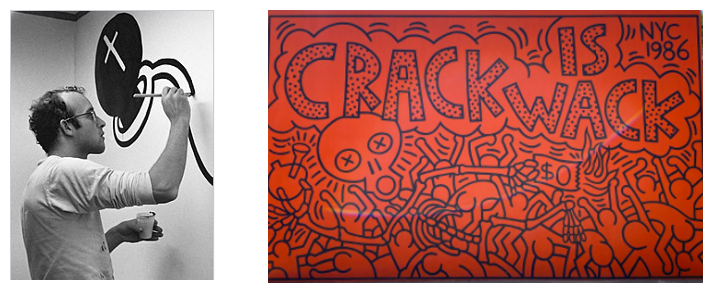
(Left) Keith Haring working on a mural in Amsterdam in 1986. Photo: Wikipedia. (Right) "Crack is Wack" 1986. A New York landmark.
Here are some other examples of his work.
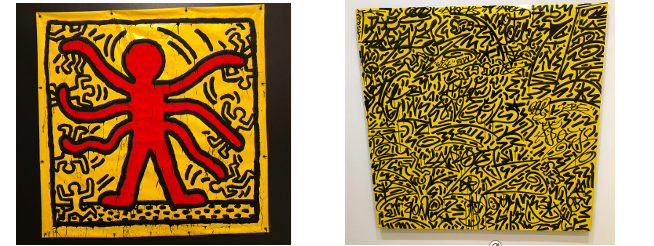
Pre-AIDS (Left) Untitled, 1982. (Right) Untitled, 1981. Lame photography: Me
Post-AIDS
Haring was diagnosed with AIDS in 1987. Even rank amateurs like myself can see how Haring's mood, as reflected by his art, became dark as his health began to fail. If you look closely, there are some fairly obvious references to birth, death, illness, running out of time, and other catastrophes.
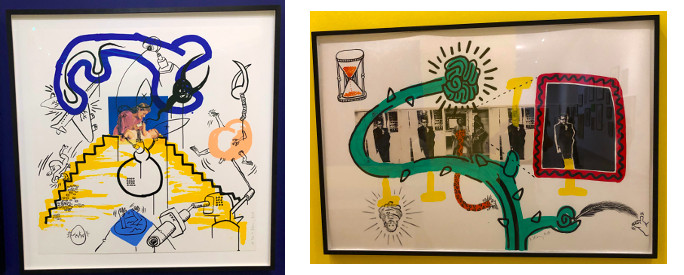
(Left) Apocalypse 1-10 (1988). (Right) Untitled (1988)
Timing is everything
It is not clear when Haring first became infected, but it's a reasonable guess that it was probably something like five years before Johnson, maybe more. Those years cost him his life. To understand why this is so, we need to look at the AIDS timeline, all the way back to 1981. I modified the chart below, originally published by the CDC, for clarity, especially to highlight the difference in the outcome of AIDS patients depending on where they contracted the virus.
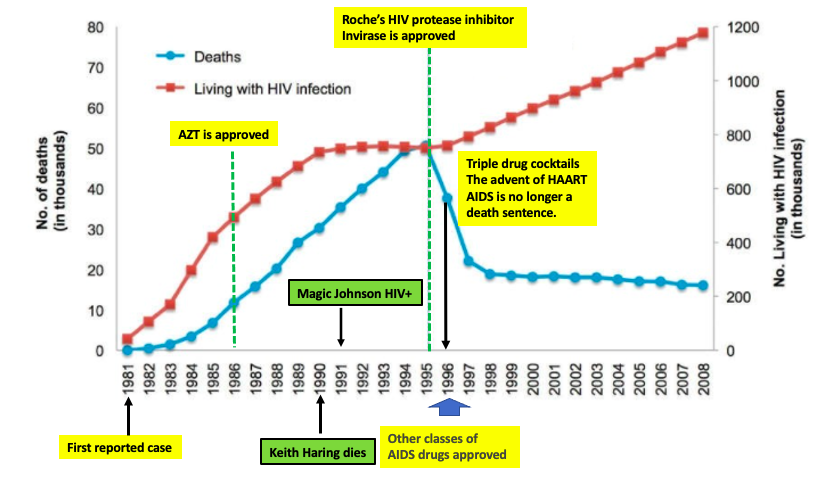
- 1981 - First AIDS cases detected in Los Angeles.
- 1986 - AZT, the first AIDS drug, is approved. It is expensive, toxic, and only marginally helpful.
- 1990 - Keith Haring dies.
- 1991 - Magic Johnson announces he has been infected with HIV.
- 1995 - The first successful AIDS drug, Roche's Invirase, is approved. Deaths begin to decline for the first time.
- Late 1996 - The advent of HAART (4) triple-drug cocktails. AIDS is no longer a death sentence.
Relevance to today
It may not be obvious, but Invirase and Paxlovid, arguably two of the most important drugs ever discovered, work the same way. Both drugs act by inhibiting the viral proteases responsible for the replication of HIV and COVID, respectively. This is no coincidence. The technology used to develop Invirase was used a decade later, resulting in two FDA-approved protease inhibitors of hepatitis C protease – the first direct-acting antiviral drugs to treat hepatitis C. Likewise, research in the early 2000s (for the original SARS) led to the discovery of Paxlovid two decades later. Had Pfizer not undertaken research back then, we wouldn't have Paxlovid today; It would be years from now.
It's all about timing.
NOTES
(1) There may be some irony about me being married to a therapist.
(2) These drugs resulted from the combined efforts of government and academic labs as well as drug companies
(3) Haring did not consider himself to be a graffiti artist.
(4) HAART is short for Highly Active Antiretroviral Therapy



